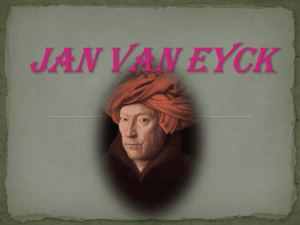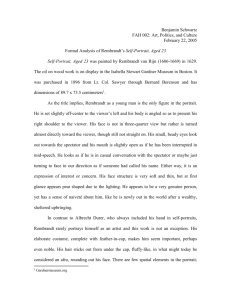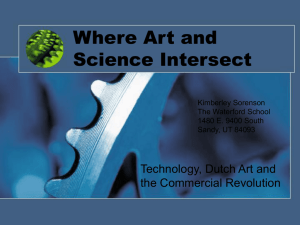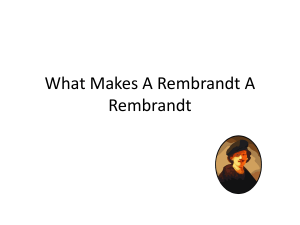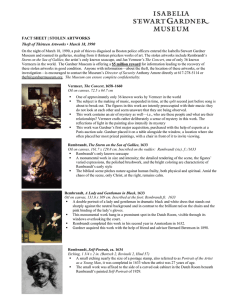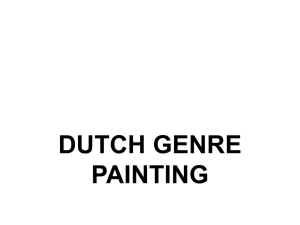Lecture 6: Art of Description Northern Art 15 th
advertisement
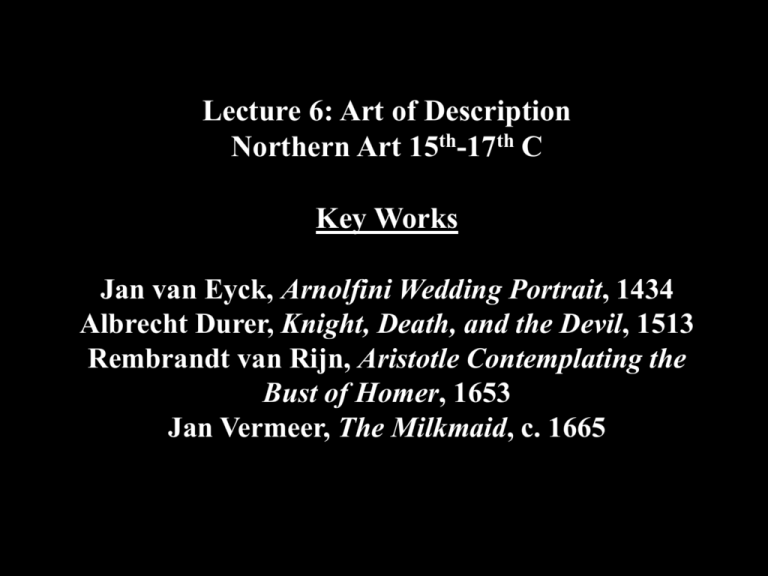
Lecture 6: Art of Description Northern Art 15th-17th C Key Works Jan van Eyck, Arnolfini Wedding Portrait, 1434 Albrecht Durer, Knight, Death, and the Devil, 1513 Rembrandt van Rijn, Aristotle Contemplating the Bust of Homer, 1653 Jan Vermeer, The Milkmaid, c. 1665 Lecture 6: Art of Description Northern Art 15th-17th C Key Terms linseed oil engraving/etching genre scene camera obscura Jan Van Eyck, Man in a Red Turban, 1433, National Gallery London Self portrait of Jan Van Eyck the court painter and valet de chamber to Duke Phillip the Good of Burgundy. Van Eyck was one of the first to use linseed oil as a paint medium. With the oil medium, it was possible to blend colors and achieve a more translucent effect, imitating the play of light. Jan Van Eyck, Giovanni Arnolfini and His Bride 1434, oil on wood, National Gallery, London. Secular image that memorializes a marriage. Painting serves as proof of the marriage as the presence of two witnesses are reflected in the mirror. Also, above the mirror – Jan van Eck signs, Johannes Eyck fuit hic – was here. Therefore, the painting itself becomes both pictorial and written proof, documenting the marriage. Christian iconography abounds as many of the ordinary objects have sacred significance. Hieronymus Bosch, Garden of Earthly Delights, creation of Eve at left, Garden at center, and hell at right, 1505-10 oil on wood Three outer panels – work is a triptych format. The work is full of symbolic complexity and surreal images that depict the creation of the world. Albrecht Durer, Self Portrait, 1500 Durer was one of the first artists outside of Italy to become an international art celebrity. He was friends with many of the leading humanists of his day including Erasmus. Penetrating self portrait. Paints himself like Christ. Durer, The Fall of Man, 1504, engraving Two idealized figures of Adam and Eve standing poses reminiscent of classical statues yet blended with his northern well honed observational skills in his rendering of the background foliage and animals. Engraving: lines are cut into a polished surface of a copper plate with a burin or engraving tool Durer, The Fall of Man, 1504 Masaccio, Expulsion of Adam and Eve from Eden, 1425 – Brancascci Chapel, Florence, Italy. Albrecht Durer, Knight, Death and the Devil, 1513, Engraving Knight is a soldier of Christ. Armed with his faith, the warrior repels the threat of death who appears as the cadaver with snakes and the devil, the horned creature who follows him. Iconography would have been obvious to viewers at the time. Equestrian statues were a renaissance favorite. Peter Brueghel, Hunters in the Snow, 1565, oil on panel. We see a valley full of ponds, a winding river, steeply roofed houses and steepled churches, many people skating, many trees and hills, and some of the sharpest mountain crags ever. Nature is closely rendered yet human activity takes center stage. Good example of a genre scene – a scene of everyday life Rembrandt van Rijn, Self Portrait in a Cap, 1630, etching Etching: process where a metal plate is covered with a protective coating of acid resistant material. The artist than draws through the ground with a pointed tool exposing metal. The plate is then immersed in an acid bath which makes grooves where the metal was exposed. The young Rembrandt mugs into a mirror, using his own face as a cheap model to practice the expression of various emotions. Rembrandt was interested in emotion and expression, and studied ways to express psychological states. Rembrandt, Nicholas Ruts 1631 Kind of portrait that made Rembrandt’s living. Ruts was a wealthy fur trader. An impression of immediacy and alertness. Use of subtle light is key. Rembrandt, The Anatomy Lesson of Dr. Tulp, 1632 Members of the surgeons guild commissioned this work. Dr Tulp, a noted physician, is in the act of dissecting. Corpse is diagonal, foreshortened. Each of the students it specifically painted – great nuance in expression and facial detail. Rembrandt Aristotle Contemplating the Bust of Homer, 1653 Metropolitan Museum of Art We see Aristotle in a unique costume, fingering the gold chain given to him by Alexander the Great, his most famous pupil. One hand on the chain, the other on the bust of Homer contemplating the world of the mind vs world of man and possessions. Autobiographical undertones. By the time Rembrandt did this work, Rembrandt’s fortunes had declined. Jan Vermeer, The Letter, 1666 Genre picture - scene of everyday life. A maid has handed a well dressed woman a love letter. This is reinforced by various symbols. The woman plays the lute – the traditional symbol of the music of love, also the seascape behind n the back wall served as a symbol of love requited referring to a 1534 publication, Love Emblems. Vermeer, Milkmaid, c 1665 Vermeer is concerned with the play of light on objects and the rendering of optical illusions He used a camera obscura – an ancestor to the modern camera based on passing light through a tiny pin hole or lens to project an image on a screen or the wall of a room. The use of the camera obscura helped him to rework the composition and place his figures and furniture in stable relationships – creating the classical serenity of his works. Vermeer replicated the unfocused appearance of the motifs that he would have seen through the camera obscura by applying his famous pointillés or “circles of confusion” (small dots of paint employed to yield the effect of broken contours and dissolved forms in light). Pointillés are used to impart an extraordinary tactile reality to such objects as the chunks of bread. The chunks are encrusted with so many pointillés that these dots of paint seem to exist independently of the forms they describe. Vermeer, The Lacemaker, 1665-1670 Stylish woman makes lace which was popular among Dutch women. This is not for profit but as an indication that northern women were as accomplished at the production of luxury goods as their French and Flemish counterparts. Stylish woman absorbed in her task. Rich colors and fabrics reinforce the intimacy.

